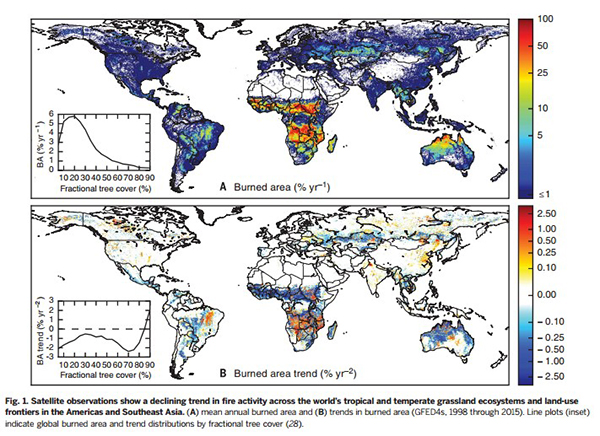最新科研进展
A human-driven decline in global burned area
Authors:
Andela, N.1,2, Morton, D.C.1, Giglio, L.3, Chen, Y.2, van der Werf, G.R.4, Kasibhatla, P.S.5, DeFries, R. S.6, Collatz, G. J.1, Hantson, S.7, Kloster, S.8, Bachelet, D.9, Forrest, M.10, Lasslop, G.8, Li, F.11, Mangeon, S.12, Melton, J. R.13, Yue, C.14, Randerson, J.T.2
1 Biospheric Sciences Laboratory, NASA Goddard Space Flight Center, Greenbelt, MD 20771, USA, 2 Department of Earth System Science, University of California, Irvine, CA 92697, USA, 3 Department of Geographical Sciences, University of Maryland, College Park, MD 20742, USA, 4 Faculty of Earth and Life Sciences, Vrije Universiteit Amsterdam, Amsterdam, the Netherlands, 5 Nicholas School of the Environment, Duke University, Durham, USA, 6 Department of Ecology, Evolution, and Environmental Biology, Columbia University, New York, NY 10027, USA, 7 Karlsruhe Institute of Technology, Institute of Meteorology and Climate research, Atmospheric Environmental Research, 82467 Garmisch-Partenkirchen, Germany, 8 Max Planck Institute for Meteorology, Bundesstra?e 53, 20164 Hamburg, Germany, 9 Biological and Ecological Engineering, Oregon State University, Corvallis, OR 97331, USA, 10 Senckenberg Biodiversity and Climate Research Institute (BiK-F), Senckenberganlage 25, 60325 Frankfurt am Main, Germany, 11 International Center for Climate and Environmental Sciences, Institute of Atmospheric Physics, Chinese Academy of Sciences, Beijing, China, 12 Department of Physics, Imperial College London, London, UK, 13 Climate Research Division, Environment Canada, Victoria, BC, V8W 2Y2, Canada, 14 Laboratoire des Sciences du Climat et de l’Environnement, LSCE/IPSL, CEA-CNRS-UVSQ, Université Paris-Saclay, 91198 Gif-sur-Yvette, France
Abstract:
Fire is an essential Earth system process that alters ecosystem and atmospheric composition. Here we assessed long-term fire trends using multiple satellite data sets. We found that global burned area declined by 24.3 ± 8.8% over the past 18 years. The estimated decrease in burned area remained robust after adjusting for precipitation variability and was largest in savannas. Agricultural expansion and intensification were primary drivers of declining fire activity. Fewer and smaller fires reduced aerosol concentrations, modified vegetation structure, and increased the magnitude of the terrestrial carbon sink. Fire models were unable to reproduce the pattern and magnitude of observed declines, suggesting that they may overestimate fire emissions in future projections. Using economic and demographic variables, we developed a conceptual model for predicting fire in human-dominated landscapes.
Key words:
global fire, decline, human

Citation:
Andela, N., Morton, D. C, Giglio, L., Chen, Y., van der Werf, G.R., Kasibhatla, P. S, DeFries,R.S., Collatz, G. J., Hantson, S., Kloster, S., Bachelet, D., Forrest, M., Lasslop, G., Li. F.,Mangeon, S., Melton, J.R, Yue, C, Randerson, J.T.: A human-driven decline in global burned area, Science, 365, 2017
